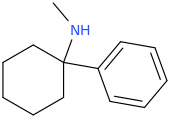xen2xen
Greenlighter
- Joined
- Oct 22, 2020
- Messages
- 14

This base arylcylclohexylamine is now beginning to show up on the markets. How exciting! To my knowledge, base arylcyclohexylamines have not been offered at the retail level in quite some time.
I suggest that PCMe or NMPCA (N-methyl-1-phenylcyclohexylamine) be used to refer to this molecule, as PCM has previously been used to refer to the N-morpholine analog. However, some vendors are still using PCM to refer to this molecule.
The only report I have been able to find comes from adder's thread on PCP analogs, PCP analogs (Cumulative) - Retrospective - Bioassays:
PCM, N-methyl-1-phenylcyclohexanamine
Route/dose: 15mg intranasally of HCl salt
Report: Nothing else beside what I would have expected from this compound. It's safe to say it's as potent as PCP. However, as with PCE, there's a distinctive feel to it. Piperidine ring broken compounds have somewhat different intoxicating effects from PCP, more bodyload, different taste, different smell.
I am looking forward to hearing what others think of this dissociative in the coming weeks
